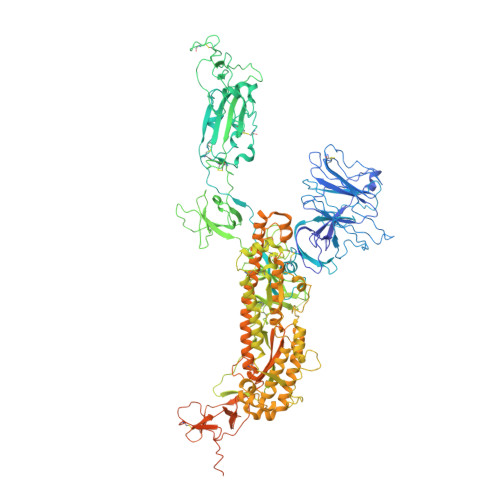Spike N354 glycosylation augments SARS-CoV-2 fitness for human adaptation through structural plasticity.
Liu, P., Yue, C., Meng, B., Xiao, T., Yang, S., Liu, S., Jian, F., Zhu, Q., Yu, Y., Ren, Y., Wang, P., Li, Y., Wang, J., Mao, X., Shao, F., Wang, Y., Gupta, R.K., Cao, Y., Wang, X.(2024) Natl Sci Rev 11: nwae206-nwae206
- PubMed: 39071099
- DOI: https://doi.org/10.1093/nsr/nwae206
- Primary Citation of Related Structures:
8WHS, 8WHU, 8WHV, 8WHW, 8WHZ, 8X4H, 8X4Z, 8X50, 8X55, 8X56, 8X5Q, 8X5R, 8XUR, 8XUS, 8XUT, 8XUU - PubMed Abstract:
Selective pressures have given rise to a number of SARS-CoV-2 variants during the prolonged course of the COVID-19 pandemic. Recently evolved variants differ from ancestors in additional glycosylation within the spike protein receptor-binding domain (RBD). Details of how the acquisition of glycosylation impacts viral fitness and human adaptation are not clearly understood. Here, we dissected the role of N354-linked glycosylation, acquired by BA.2.86 sub-lineages, as a RBD conformational control element in attenuating viral infectivity. The reduced infectivity is recovered in the presence of heparin sulfate, which targets the 'N354 pocket' to ease restrictions of conformational transition resulting in a 'RBD-up' state, thereby conferring an adjustable infectivity. Furthermore, N354 glycosylation improved spike cleavage and cell-cell fusion, and in particular escaped one subset of ADCC antibodies. Together with reduced immunogenicity in hybrid immunity background, these indicate a single spike amino acid glycosylation event provides selective advantage in humans through multiple mechanisms.
Organizational Affiliation:
CAS Key Laboratory of Infection and Immunity, National Laboratory of Macromolecules, Institute of Biophysics, Chinese Academy of Sciences, Beijing 100101, China.
















